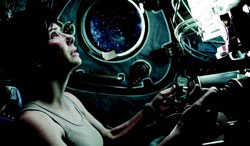OSCAR NOMINEE REVIEWS
 Outer space has always been characterized by the dichotomy of inexplicable beauty and overwhelming terror. Director Alfonso Cuarón depicts the great unknown as such in his Oscar-nominated film, “Gravity,” using innovative 3D technologies to take his audiences on an otherworldly adventure. The film’s cinematography (done by visual expert Emmanuel Lubezki) is arguably the best of 2013’s lineup and succeeds in establishing realism in an otherwise fantastical story.
Outer space has always been characterized by the dichotomy of inexplicable beauty and overwhelming terror. Director Alfonso Cuarón depicts the great unknown as such in his Oscar-nominated film, “Gravity,” using innovative 3D technologies to take his audiences on an otherworldly adventure. The film’s cinematography (done by visual expert Emmanuel Lubezki) is arguably the best of 2013’s lineup and succeeds in establishing realism in an otherwise fantastical story.
“Gravity” begins with simple statements on a black screen, providing the viewer with textbook information about space before Cuarón drives his point home, delivering a 12-minute long panoramic view of the Earth. The shot is captivating and instills in onlookers a real sense of weightlessness.
For those who prematurely believe that the film is nothing more than astronauts floating in space, these opening scenes may not show much potential. But much like one of the film’s prevailing themes, it’s worth sticking around for the ride – especially when a nearby shuttle just exploded.
The debris is headed towards a US shuttle where two astronauts are in the middle of conducting research when they receive word from Houston about the impending collision. Matt Kowalski is the veteran of the duo, played with an off-beat reverence by George Clooney. With him on this routine mission is Dr. Ryan Stone, a medical engineer played by Sandra Bullock, who has no previous experience in a space suit but a ton of emotional baggage.
In terms of social conduct, these two characters are perfect opposites. It is only after some persistent prodding by Kowalski that we uncover a personal detail crucial to Stone’s character development: her only daughter died when she was just a young girl. Shortly after this information settles on the audience, the emotional moment is interrupted by one of utter terror, as the debris finally makes contact with the US shuttle.
Cuarón’s use of technology makes “Gravity” a very effective thriller, in that the viewer is placed directly in the action. IMAX audiences will especially appreciate this illusion, as pieces of the space shuttle seem to fly right off the screen.
When one considers how the landlocked actors performed their sequences, the innovative filming technique becomes even more extraordinary. Confined to an LED screen box, Clooney and Bullock acted out their scenes with no more than a space suit to provide character inspiration. With this resourceful decision by cinematographer Lubezki, the film’s lighting gives the characters a fitting sense of fragility.
Ultimately, though, it is not the cinematography that keeps viewers engaged, but the emotional (and surprisingly relatable) story of Dr. Ryan Stone.
The film’s greatest triumph lies in the character arc portrayed by Bullock, who is impressively convincing as a woman whose torturous past has left her with little to live for. Still grieving over the loss of her child and convinced that she can’t carry on, Stone is faced with a question: Would dying in space really be so bad? Though the answer seems obvious, in Stone’s emotional state, never returning to Earth is presented as an easy solution to all her problems. Separated from Kowalski and with no clear way home, she could very effortlessly succumb to her sorrows.
It is this emotional turning point that drives the heart of the story, and leaves viewers rooting for a character that struggles to root for herself. Though the film very obviously portrays Stone’s plot as a choice between life and death, it takes on a bigger meaning as the terror of outer space becomes a backdrop for the terror of moving on. In the end, Stone must rediscover that life on Earth is worth living.
The importance of this plotline is conspicuously absent from the movie trailers but perhaps rightfully so. Cuarón’s plot unfolds so organically that to give away the truths uncovered in the character development might make the film less powerful. Trailers showing Bullock and Clooney simply dodging items in space, however, might not have done the film any favors, as many have written it off as boring or trite. But it would be a mistake to overlook this gem based on any preconceived notions. Allow yourself to get lost in the story, and as Dr. Ryan Stone can tell you, you’ll be in for “one hell of a ride.”
IMAGE TAKEN from motherjones.com



